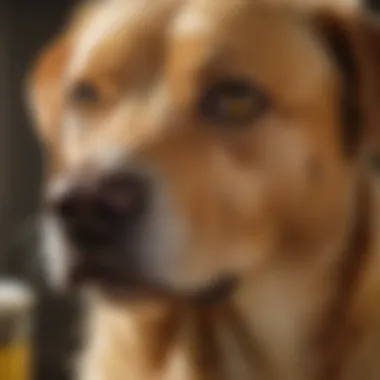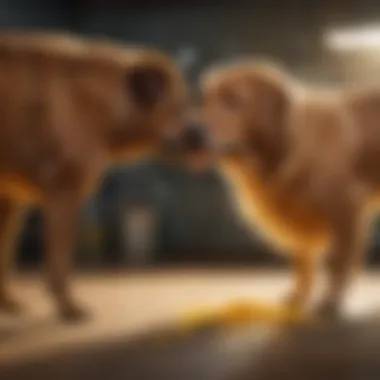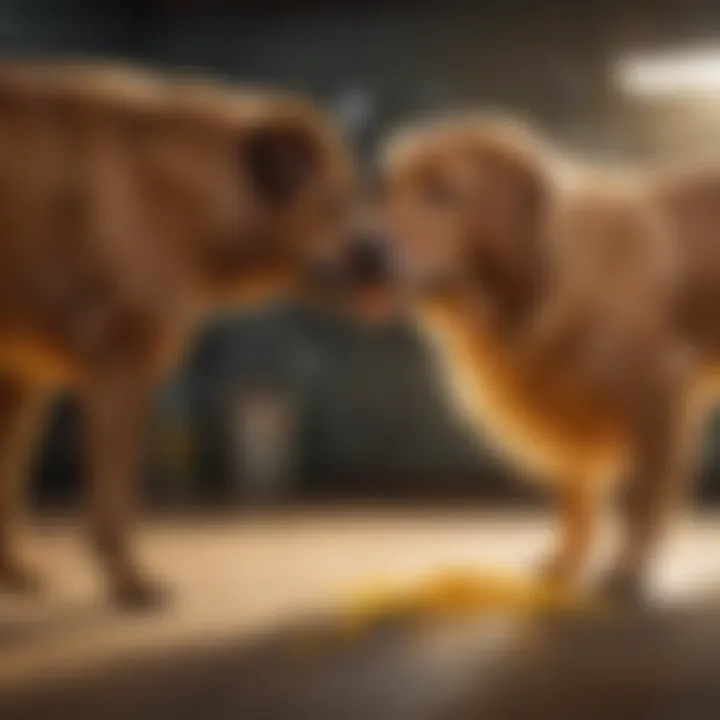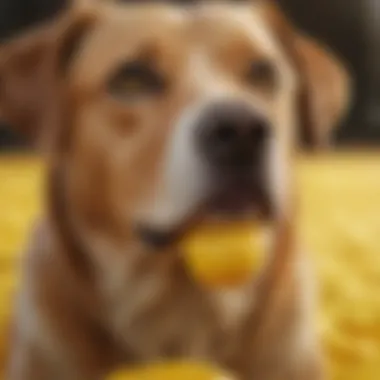Understanding Yellow Diarrhea in Dogs: Causes and Care


Intro
When talking about our canine companions, it’s easy to get lost in the cuteness of wagging tails and slobbery kisses. However, as responsible pet owners, understanding the nuances of our dogs' health is just as important as their moments of joy. One particularly concerning issue that can arise is yellow diarrhea. It’s a signal that something might be off in the digestive tract, and recognizing the signs early can make a world of difference.
Many factors can contribute to this condition, ranging from dietary missteps to underlying infections or medical conditions. It’s crucial for dog owners to grasp not only the potential causes of yellow diarrhea but also what it signifies about their pet’s overall wellbeing. Addressing this condition entails looking beyond just the symptom to grasp the complete picture—including when the situation calls for a vet’s expertise.
This article dives into yellow diarrhea in dogs, uncovering the many layers tied to its causes, implications for health, and practical steps for treatment and prevention.
Prolusion to Diarrhea in Dogs
Diarrhea in dogs often serves as more than just a nuisance for pet owners; it’s a window into their furry friends' digestive health. By understanding the dynamics of this condition, owners can take proactive steps to ensure the well-being of their pets. Recognizing diarrhea as a symptom can highlight underlying issues, whether they are dietary, infectious, or indicative of more serious medical conditions.
Significance of Diarrhea as a Symptom
When a dog experiences diarrhea, it’s not merely a change in stool consistency. Diarrhea is a signal from your pet's body, indicating something may be amiss. Tracking these changes can help pinpoint potential triggers, from sudden dietary shifts to infections. It's a common misconception that loose stools are always harmless, but they can sometimes be a sign of serious health concerns. Owners might observe a variety of symptoms along with diarrhea, like lethargy or vomiting, which can hint that a trip to the vet is in order. Recognizing the importance of these signs can lead to timely interventions.
"A dog's stool can tell you a lot more than you might think—don’t ignore the clues it provides!"
Understanding Dog Digestion
To appreciate why diarrhea occurs, a basic understanding of canine digestion is vital. Dogs are omnivores, and their digestive systems are designed to process a mix of nutrients. Food enters through the mouth, travels down the esophagus, and is processed in the stomach. Here, gastric acids break down food for nutrient absorption in the intestines. However, if something disturbs this complex journey, it can lead to diarrhea.
Several factors can impact digestion:
- Diet: What your dog eats plays a crucial role. A diet lacking in essential nutrients can disrupt digestive health.
- Health Conditions: Conditions such as pancreatitis or liver disease can profoundly affect digestion.
- Allergies: Some dogs develop allergies to specific proteins, which can lead to inflammation and upset stomachs.
Understanding these elements creates a framework for recognizing the causes of yellow diarrhea. Owners can better advocate for their pets by being informed on how a dog's digestive system operates. This helps in interpreting symptoms accurately, thereby ensuring their beloved pets receive the care they need.
What Does Yellow Diarrhea Indicate?
Yellow diarrhea is more than just a color change; it can serve as a telling sign of various underlying issues in a dog’s health. While it might not seem crucial at first glance, understanding what yellow diarrhea indicates is vital for pet owners. It allows you to effectively interpret the message your dog’s body is sending, which could lead to early diagnosis and treatment of more serious conditions. Identifying these signs can save you from a lot of worry and, crucially, keep your furry friend comfortable and healthy.
Color and Consistency as Diagnostic Clues
The hue and texture of your dog’s stool can provide essential insights. Yellow diarrhea usually stems from issues related to the diet or gastrointestinal system. The color might hint at undigested bile, which can suggest a few things. For example, if the stools are watery and yellowish, it could indicate that your dog’s body is struggling to process their food. Alongside color, consistency is equally telling. A mushy stool may point to digestive upset, while a more liquid puff can signal immediate concern.
- Key indicators to note:
- Dark yellow: Could signal dehydration or bile issues.
- Bright yellow: Might suggest a playful mix of canines having a little too much fun in the trash can.
"Never ignore the color and consistency of your dog's stool; they are clues that could lead you to understanding their health better."
Common Causes of Yellow Diarrhea
When it comes to yellow diarrhea, several potential causes may lurk behind that unappealing color. Here are some notable culprits dog owners should be aware of:
- Dietary Blunders: Sometimes, your dog simply had a little too much of a good thing. Foods high in fat or sudden changes in diet can disrupt normal digestion, leading to yellow stool.
- Infections: Various infections, especially those brought on by bacteria like Salmonella, could result in the yellow aftermath.
- Parasites: Little invaders such as Giardia can mess up your pup's digestive system, producing color changes in their waste.
- Pancreatic Issues: If the pancreas is not producing enough enzymes, it can alter the digestive process, often leading to yellow and foul-smelling diarrhea.
Being observant and informed is key. If you see yellow diarrhea persisting for more than a day or two, it might be wise to dive deeper into the situation and consult with a veterinarian. They can pinpoint the exact cause and make sure your dog gets back on the right track.
Dietary Factors Contributing to Yellow Diarrhea
Understanding the dietary factors that can lead to yellow diarrhea in dogs is crucial for pet owners. Diet lays the groundwork for the overall health and well-being of a dog, influencing not only digestion but also the immune system and energy levels. When a dog experiences yellow diarrhea, it often signals that something is amiss within its dietary intake or digestive process. By recognizing the connection between diet and gastrointestinal symptoms, owners can make informed decisions to rectify issues before they escalate.
Nutritional Imbalances
Nutritional imbalances are a prime suspect in the case of yellow diarrhea. Dogs require a balanced diet comprising proteins, fats, carbohydrates, vitamins, and minerals. When one or more of these essential nutrients are lacking or in excess, it can disrupt the digestive process. For instance, too much fat can lead to inadequate digestion, causing yellowish stools due to undigested material. On the flip side, a deficiency in certain nutrients can hinder the absorption of proper digestive substances, leading to loose stools with an off-color.


It's worth noting that not all dog foods are created equal. Some cheaper brands might skimp on vital nutrients, leaving a dog to face the repercussions. Pet owners are encouraged to carefully read ingredient labels and ensure their dog's food contains quality sources of nutrition, rather than fillers or artificial components. A balanced diet is not only vital for digestion but also for maintaining overall health and vitality.
Food Allergies and Intolerances
Food allergies and intolerances present another layer of complexity regarding yellow diarrhea. As dogs consume various ingredients, some may develop allergies to certain proteins or grains. This is not just a matter of dietary preference; the body reacts negatively to these allergens, often leading to gastrointestinal distress. Symptoms may include yellow diarrhea, vomitting, or even skin irritations.
Common allergens include beef, chicken, dairy, eggs, and certain grains. For instance, a dog that is allergic to chicken may experience digestive trouble when fed chicken-based kibble. The result is usually an unhappy dog and a worried owner. Identifying these food allergies can be a process of elimination often requiring consultation with a veterinarian or using hypoallergenic food. Keeping a detailed food diary can be quite handy here; by tracking your dog's diet and symptoms, you may uncover patterns that point to the culprits behind the diarrhea.
Sudden Dietary Changes
Dogs can be creatures of habit. A sudden dietary change can often throw a wrench in their digestion, resulting in yellow diarrhea. This can happen for several reasons, such as switching types of dog food, introducing new treats, or even feeding table scraps. When a dog’s digestive system is suddenly altered, it may not adapt quickly enough, leading to poor digestion or an imbalance in gut flora.
For instance, transitioning from dry kibble to wet food might seem like a treat for your furry friend, but it can disrupt their routine. Taking baby steps to change a dog's diet is always a smart move. Gradually mixing the new food with the old over a week or more can allow the digestive system to adjust without causing upset. Remember, communication with your vet can help ensure that the dietary changes you wish to make will benefit your dog's health rather than cause more issues.
"Dietary choices are a reflection of love for our pets; understanding their needs shows true commitment to their well-being."
Taking care of a dog's diet isn't just about feeding them what's available. It's about ensuring that they receive the right balance of nutrients to thrive.
Infectious Causes of Yellow Diarrhea
When discussing yellow diarrhea in dogs, it’s crucial to investigate the infectious causes behind this condition. Understanding the link between infections and yellow diarrhea enables pet owners to be more proactive about their dogs’ health. Identifying the root cause can prompt swift action, ultimately easing the discomfort for our furry friends.
Infectious agents can vary widely, from bacteria to viruses and parasites. Each has its own characteristics and implications for treatment. Let's delve deeper into each category to paint a clearer picture of the risks involved.
Bacterial Infections
Bacterial infections are one of the more common culprits when it comes to yellow diarrhea. Sometimes, the bacteria that are part of a dog's normal gut flora can multiply out of control due to factors like stress, a sudden dietary change, or exposure to contaminated food or water.
Specific bacteria such as Salmonella, Clostridium perfringens, and Campylobacter are known to cause gastrointestinal distress. Here’s a snapshot of their implications:
- Salmonella: Often contracted from raw food diets or exposure to fecal matter. Symptoms can be severe, ranging from vomiting to lethargy.
- Clostridium perfringens: Generally found in environments where cooking practices hinge on mishandling of meats. This bacteria can cause yellow diarrhea along with abdominal pain.
- Campylobacter: Usually caught from undercooked poultry. It’s more common in puppies and can lead to severe diarrhea.
If you suspect a bacterial infection, consulting a veterinarian is step number one, as proper diagnostic work can identify the precise nature of the infection and appropriate treatment measures.
Viral Infections
Viral infections represent another key factor in yellow diarrhea among dogs. Viruses can lead to significant digestive troubles, and often the symptoms can escalate rapidly. Common viruses involved include parvovirus and rotavirus.
- Canine Parvovirus: Particularly notorious, parvovirus affects young dogs more severely. It attacks the intestinal lining and can lead to severe dehydration, necessitating immediate veterinary intervention.
- Canine Rotavirus: Less severe than parvovirus but can still cause yellow diarrhea, particularly in puppies. Typically, it resolves on its own, though supportive care can help manage symptoms.
Viral infections often require a detailed history as well as diagnostic tests for a proper diagnosis. Vaccination can help reduce the chances of contracting some of these viruses, particularly parvovirus.
Parasitic Infections
Parasites are sneaky and can often fly under the radar until significant symptoms, like yellow diarrhea, arise. Intestinal parasites like Giardia, Coccidia, and roundworms can wreak havoc on your dog’s health.
- Giardia: A protozoan parasite that can cause malabsorption in the intestines, leading to foul-smelling yellow diarrhea. Contaminated water sources are often to blame for Giardia infections.
- Coccidia: Another protozoan parasite that’s especially common in puppies and can lead to diarrhea with a distinctive yellowish tint. This can be particularly concerning in cases of malnourishment or dehydration.
- Roundworms: These can cause diarrhea along with a host of other symptoms, including a bloated stomach. The ingestion of eggs from contaminated soil or fecal matter is a common transmission route.
Diagnosing parasitic infections typically requires a fecal examination by a veterinarian, who can recommend the right deworming treatments.
Overall, addressing infectious causes of yellow diarrhea involves a keen eye and an understanding of your dog’s behavior and health. The moment yellow diarrhea appears, it’s wise to keep a close watch and ideally reach out to a vet for advice. Early intervention can be paramount in protecting your dog’s well-being.
Medical Conditions Linked to Yellow Diarrhea
Understanding the correlation between yellow diarrhea and underlying medical conditions is crucial for dog owners. Yellow diarrhea can sometimes be a mere dietary hiccup, but more often, it signals deeper health issues that require attention. Recognizing that a dog's digestive upset might stem from serious medical conditions can lead to prompt veterinary intervention, ultimately safeguarding your pet's well-being. This section aims to illuminate three significant medical conditions related to yellow diarrhea, highlighting their implications and what pet owners should be aware of.
Liver Disease


Liver disease in dogs can manifest in various ways, one of which is the presence of yellow diarrhea. The liver plays a vital role in digestion and metabolism, and its impairment can drastically affect a dog's overall health. When the liver struggles to function properly, bile production may be compromised. Bile is responsible for the breakdown of fats and can impart a yellowish hue to the stool if there's an issue with its flow or composition.
Common signs of liver disease include:
- Jaundice (yellowing of the skin and eyes)
- Increased thirst and urination
- Symptoms of lethargy or weakness
- Loss of appetite or weight loss
If a dog exhibits any combination of these signs alongside yellow diarrhea, it’s time for a trip to the vet. Early detection can make all the difference in effectively treating liver conditions.
Pancreatitis
Pancreatitis is another serious condition that can lead to yellow diarrhea in dogs. This inflammation of the pancreas can occur due to dietary indiscretion, such as consuming fatty table scraps or even sudden changes in food. The pancreas is essential for digesting nutrients and producing insulin; thus, its inflammation can wreak havoc on a dog’s digestive health.
Dogs suffering from pancreatitis may display symptoms like severe abdominal pain, vomiting, and yellow diarrhea. Symptoms can worsen quickly, so prompt veterinary care is vital. Additionally, some breeds, like Miniature Schnauzers and Yorkshire Terriers, are more prone to developing pancreatitis, which means owners should remain vigilant.
Gastrointestinal Disorders
Gastrointestinal disorders encompass a broad range of health issues, from infections to chronic conditions like inflammatory bowel disease (IBD). These disorders can disrupt normal digestion and absorption of nutrients, leading to yellow diarrhea as one possible outcome.
Common gastrointestinal disorders include:
- Infections: Bacterial, viral, or parasitic infections can seriously affect gut health, resulting in the production of abnormal stool.
- Inflammatory Bowel Disease (IBD): A condition characterized by chronic inflammation of the gastrointestinal tract leads to malnutrition and change in stool color.
- Food Sensitivities: Some dogs may have specific sensitivities that trigger gastrointestinal disturbances, often leading to yellow diarrhea.
If your dog consistently experiences changes in their stool alongside other gastrointestinal symptoms, it would be prudent to consult with a veterinarian who can offer diagnostic testing and treatment options.
Remember: Early identification and intervention in the context of serious health conditions can contribute to a better prognosis and a smoother recovery for your furry friend.
When to Seek Veterinary Help
Recognizing when to reach out for veterinary assistance can be a daunting task for dog owners, especially when their pet is experiencing yellow diarrhea. Failing to act in a timely manner can lead to serious health implications. This part of the article will delve into critical signs that point toward the necessity for professional care and why it’s better to err on the side of caution.
Signs of Dehydration
Dehydration is a primary concern when a dog has diarrhea, particularly if the stool is frequent and watery. Dogs can lose fluids rapidly, and without intervention, this may escalate into a more severe condition. Here are some key indicators to watch for:
- Dry Gums and Nose: A healthy dog's gums should be moist and the nose slightly damp. If your dog's gums appear dry or sticky, it could signify dehydration.
- Loss of Skin Elasticity: Gently pinch the skin on the back of their neck. If it doesn’t return to its normal position quickly, this can be a sign of dehydration.
- Lethargy: A normally playful dog that's suddenly low-energy may be suffering from dehydration and other serious issues.
- Increased Thirst: If your dog is drinking more water than usual, it may be their body's way of trying to recover lost fluids.
Remember: "A small amount of yellow diarrhea can be normal, but consistent watery output means your dog might not be keeping fluids in-check."
Accompanying Symptoms of Concern
Apart from dehydration, yellow diarrhea can present with other symptoms that may signal the need for veterinary evaluation. Being vigilant about these accompanying signs is key to timely intervention:
- Vomiting: Frequent vomiting alongside diarrhea may indicate a more serious gastrointestinal issue.
- Bloody Stool: If you notice traces of blood in the stool, it’s a red flag that shouldn’t be ignored.
- Severe Abdominal Pain: Signs of discomfort, such as whining or a bloated appearance, might suggest underlying pain that requires assessment.
- Fever: Elevated body temperature may be a sign of infection or another serious condition.
In summary, dogs can face a myriad of digestive issues that manifest as yellow diarrhea. Recognizing the signs that warrant professional help can mean the difference between a minor issue and something far more serious. Your chosen vet can guide you through the appropriate steps to ensure your dog receives the treatment needed for a swift recovery.
Treatment Options for Yellow Diarrhea
Understanding appropriate treatments for yellow diarrhea in dogs is crucial for pet owners to ensure the well-being of their furry companions. Diarrhea can often be a symptom of underlying health issues, and timely intervention can make all the difference in recovery and comfort for your pet. This section outlines various treatment avenues available for yellow diarrhea, focusing on the importance of dietary adjustments, medications, and hydration.
Dietary Adjustments
One of the first steps in addressing yellow diarrhea is evaluating the dog’s diet. Making thoughtful alterations can lead to significant improvements. A bland diet—think boiled chicken and rice—might be a good starting point. This is easier on the digestive system and can help firm up stool consistency. Gradually introducing regular food back into their meal routine can then be done once the diarrhea subsides, ensuring to monitor for any adverse reactions.
It’s also wise to consider the quality of dog food currently being fed. Lower-grade commercial dog foods often have poor digestibility and may include fillers that could irritate the gastrointestinal (GI) tract. Transitioning to high-quality brands can make a noticeable difference. Additionally, some dogs benefit from specialized diets designed for sensitive stomachs or those low in fat, which is particularly helpful in cases like pancreatitis.
Some owners have found success incorporating probiotics into their pet's diet. These can restore the balance of healthy gut bacteria and support overall digestive health. It’s always best to consult with a veterinarian before making any drastic dietary changes, ensuring that any new food or supplements align with your dog’s specific needs.


Medications and Their Uses
In certain situations, medication may be necessary to address yellow diarrhea. These typically include anti-diarrheal medications that can help soothe the digestive tract, and sometimes antibiotics if a bacterial infection is suspected. Metronidazole and fenbendazole are common medications used for treating infections and other digestive issues. However, it’s essential not to administer any medication without a vet’s guidance, as the dog's specific condition and medical history need to be considered.
Moreover, some medications focus on underlying conditions causing the diarrhea. For instance, a dog suffering from inflammatory bowel disease may need steroids or other immunosuppressive drugs. The important takeaway here is to be vigilant; self-medication or guessing can lead to complications or worsening of the condition.
Hydration and Supportive Care
Hydration is a critical aspect of treating yellow diarrhea. Diarrhea can rapidly lead to dehydration, particularly in smaller breeds or younger dogs. Pet owners should monitor their dog's water intake closely and encourage drinking more fluids. Sometimes adding a little low-sodium broth can entice your dog to drink more.
In more severe cases, a vet may recommend electrolyte solutions formulated specifically for pets. If the diarrhea persists or the dog shows signs of dehydration, such as lethargy, dry gums, or excessive panting, immediate veterinary attention is crucial.
Supportive care may also include monitored recuperation at home. Creating a comfortable space for your dog can help them relax and recover more quickly. Ensure access to a clean space and regular check-ins, as well as a potential return visit to the vet if there's little change in their condition.
"A mindful approach to treatment not only benefits your dog’s health but can strengthen the bond between you two—after all, they rely on you for care and support when they're unwell."
By focusing on dietary changes, appropriate medications, and ensuring hydration, you can effectively manage your dog’s yellow diarrhea while safeguarding their health. Each step taken not only addresses immediate concerns but also contributes to long-term digestive health.
Preventative Measures for Digestive Health
Keeping your dog in good digestive health is not just about reacting to issues but also about taking proactive steps to prevent them. A number of well-implemented preventative measures can go a long way in reducing the likelihood of yellow diarrhea and other digestive problems. These strategies focus on establishing a solid foundation for your dog’s health.
Importance of a Consistent Diet
A steady diet is vital for a dog’s digestive system. Animals are creatures of habit; if their diet varies drastically, it can lead to an upset stomach or more serious digestive issues. Feeding your dog a consistent diet ensures they receive the right balance of nutrients their body needs.
Opting for high-quality dog food, be it dry kibble or wet food, can help minimize digestive disturbances. Furthermore, if you need to switch foods, you should do it gradually. Mixing the new food with the old one over a week can help dogs adjust better. Skipping from one flavor to another like it’s a buffet won’t serve them well in the long run, and might just end up sending them running to the backyard more often than you'd want.
Regular Veterinary Check-ups
Part of a dog's routine should be regular visits to the vet. Annual or bi-annual check-ups allow for preventive measures that can catch potential health issues early on. Vets can run necessary tests to rule out underlying conditions that may not manifest through visible symptoms.
Having a professional keep tabs on your pet’s health not only gives peace of mind but also improves overall well-being. It’s not just about vaccination shots; these visits can help establish a baseline for your dog's health data. Any deviation from the norm can then be discussed in a timely manner. Remember, better safe than sorry!
Maintaining Hygiene and Safety
Good hygiene is non-negotiable when ensuring your furry friend stays healthy. Regularly cleaning your dog’s living space, including their bed, toys, and food/water bowls, can keep harmful bacteria at bay. After all, a dog’s favorite chew toys can sometimes become a treasure trove for germs if left unattended.
Along with cleaning, it’s also essential to supervise what your dog consumes. That curious nose can lead to adventures where they might munch on something they shouldn't, leading to indigestion or an upset stomach. Keeping such items out of reach can prevent unwanted health issues.
"An ounce of prevention is worth a pound of cure."
In summary, focusing on a consistent diet, attending regular vet check-ups, and maintaining high hygiene standards are fundamental elements in promoting your dog's digestive health. Implementing these measures doesn’t just minimize the chances of yellow diarrhea; it fosters an overall healthier and happier life for your canine companion.
Ending: Assessing Your Dog's Digestive Health
A dog’s digestive health is not something to be taken lightly. The presence of yellow diarrhea can often be the first indicator of underlying issues, making it crucial for pet owners to pay attention to their furry friends’ bowel movements. Understanding the implications of this symptom allows for timely and effective interventions, potentially preventing more serious health problems down the line.
Understanding the Importance of Symptoms
Symptoms like yellow diarrhea serve as a clear warning sign that something's awry in your dog's system. Dogs, much like humans, can't exactly voice their discomfort, which places the onus on us, their caretakers, to be vigilant. Recognizing a sudden change in stool color or consistency can help identify a range of conditions, from dietary indiscretion to serious medical issues such as liver disease or infections. It's essential to monitor any additional symptoms that coincide with the diarrhea, such as lethargy, appetite changes, or vomiting. Addressing these issues promptly can mean the difference between a simple diet adjustment or a more intricate treatment plan.
A Holistic Approach to Pet Care
Pet care is not just about feeding, grooming, and taking occasional trips to the vet. A holistic approach ensures that all aspects of your dog’s health are considered. This includes their physical health, diet, mental stimulation, and overall lifestyle. Implementing a balanced diet that meets nutritional needs can help improve digestive health and prevent issues like yellow diarrhea. Additionally, regular veterinary check-ups are critical, as they allow for early detection of potential problems.
Here are some suggestions to maintain digestive health:
- Maintain a consistent diet. Sudden switches in food can upset a dog's stomach.
- Stay informed. Learn about common health issues associated with your dog's breed.
- Provide mental and physical exercise. Keeping your dog active can enhance digestion and general well-being.
- Educate yourself about suitable foods. Look for quality ingredients that your dog can digest easily.
A proactive approach enables pet owners to create a nurturing environment where their dogs can thrive. Investing time in understanding your dog's health needs will not only enhance their quality of life but also strengthen the bond between you and your beloved pet. Remember, when in doubt, it's best to seek professional veterinary advice.
Always keep in mind that symptoms are there for a reason, so don't brush them off lightly. Your dog's health depends on your attentiveness.



